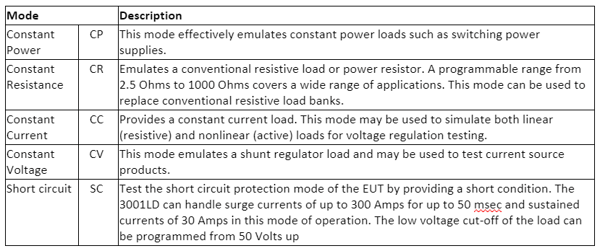Testing AC power sources, such as uninterruptible power supplies, can be a real challenge. These products are often tested with resistive load banks, but this approach does not simulate real-world conditions such as switching DC/AC converters found in many AC powered products.
As a result, using resistive load banks does not fully exercise the equipment under test (EUT) under worst case operating conditions. High peak currents and low power factor loads can significantly impact the operating characteristics of a UPS or AC power product.
A better way to test these products is with an AC electronic load, such as the California Instruments 3091LD AC eLoad. An AC electronic load can simulate high crest factor and variable power factor load conditions in addition to providing a purely resistive load, effectively simulating real-world conditions and significantly increasing product reliability. Product defects that result in costly field returns are detected well before a unit reaches a customer site.
An AC electronic load should have the following modes:

When operating in constant current or constant power mode, the electronic load supports crest factor control by narrowing the conduction angle of the current waveform in order to match the requested crest factor. Thus, the peak current is increased while retaining the RMS current level. While the apparent power remains constant, the true power decreases.
This results in a reduced true power factor. Consequently, as crest factor is increased, the true power factor automatically decreases. The load further controls power factor by shifting the current with respect to the input voltage (displacement power factor). Both leading and lagging power factor control is available. A phase shift of the current is only possible if the crest factor is higher than 1.414.
When selecting an electronic load, make sure to choose one that can dissipate all the power that your source can generate. The 3091LD AC eLoad is capable of dissipating 3000 W of single-phase AC power. For higher power or three phase applications, a 3091LD master unit can be combined with one or more auxiliary units.
Another consideration might be how easily you can use the load in an automatic test station. If this type of operating is necessary, make sure that the load has the right type of computer interface, and that measurements made by the load can be read over the interface. This functionality may allow you to eliminate the need for additional test equipment such as meters, power analyzers and oscilloscopes.
For more information on electronic loads, contact an authorized AMETEK Programmable Power sales representative in the United States by visiting https://www.powerandtest.com/sales-reps/programmable-power-sales AMETEK Programmable Power also can be contacted directly toll free at 800-733-5427 or 858-450-0085 or at ppd@ametek.com.
